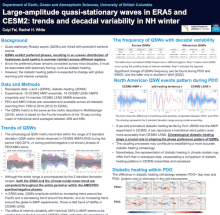Large-amplitude quasi-stationary Rossby wave events in ERA5 and the CESM2: main features and low-frequency variability in Northern Hemisphere winter
Cuiyi
Fei
University of British Columbia
Poster
High amplitude quasi-stationary Rossby waves (QSWs) have been connected to extreme weather events. By identifying particularly high amplitude QSW events (QWEs) over Europe and North America we study their characteristics in ERA5 re-analysis data and in ensemble simulations from the CESM2 general circulation model. The CESM2 reproduces the overall statistics of QWEs, with ERA5 results within the ensemble spread. The ensemble spread is large, indicating a strong influence of internal variability on QWEs. Composites of meridional wind anomalies for QWEs show a phase preference in both ERA5 and CESM2. We compare the trends and multi-decadal variability in the preferred phases in ERA5, CAM6 AMIP simulations and CESM2, and investigate the relations of this change with the modes of variability such as the PDO and AMO. Overall, the CESM2 can simulate QWEs; differences between the model ensemble mean and re-analysis could result from model bias, internal variability, or both, although biases are not reduced in CESM2 simulations forced with observed SSTs.

Poster file
fei-cuiyi-confronting-poster.pdf
(852.18 KB)
